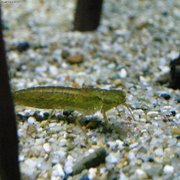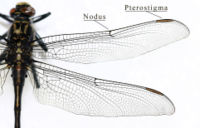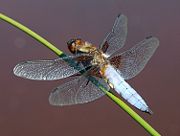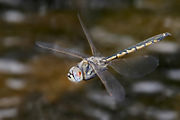Dragonfly
2008/9 Schools Wikipedia Selection. Related subjects: Insects, Reptiles and Fish
| Dragonfly | ||||||||||||
|---|---|---|---|---|---|---|---|---|---|---|---|---|
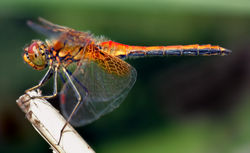 Yellow-winged Darter
|
||||||||||||
| Scientific classification | ||||||||||||
|
||||||||||||
| Families | ||||||||||||
|
Aeshnidae |
A dragonfly is an insect belonging to the order Odonata, the suborder Epiprocta or, in the strict sense, the infraorder Anisoptera. It is characterized by large multifaceted eyes, two pairs of strong, transparent wings, and an elongated body.
Dragonflies typically eat mosquitoes, midges and other small insects like flies, bees, and butterflies. They are usually found around lakes, ponds, streams and wetlands because their larvae, known as " nymphs", are aquatic. Dragonflies do not normally bite or sting humans, though they will bite in order to escape, if grasped by the abdomen. They are valued as predators that help control populations of harmful insects, such as mosquitoes.
Dragonfly Characteristics
Dragonflies are capable of hovering followed by rapid acceleration. Some nymphs even hunt on land, an aptitude which could easily have been more common in ancient times when terrestrial predators were clumsier. Giant dragonflies can glide 20 meters at 10 degrees and a velocity of 74 cm per second which is similar to some birds . They capture their prey by clasping them in legs studded with spikes. Prey can not escape by diving away because dragonflies always attack from below.
Life cycle
Female dragonflies lay eggs in or near water, often on floating or emergent plants. When laying eggs, some species will submerge themselves completely in order to lay their eggs on a suitable surface. Most of a dragonfly's life is spent in the larval, ( naiad, aka nymph) form, beneath the water's surface, using internal gills to breathe, and using extendable jaws to catch other invertebrates or even vertebrates such as tadpoles and fish. The larval stage of large dragonflies may last as long as five years. In smaller species, this stage may last between two months and three years. When the larva is ready to metamorphose into an adult, it climbs up a reed or other emergent plant at night. Exposure to air causes the larva to begin breathing. The skin splits at a weak spot behind the head and the adult dragonfly crawls out of its old larval skin, waits for the sun to rise, pumps up its wings and flies off to feed on midges and flies. The adult stage of larger species of dragonfly can last as long as four months.
Classification
Ancient dragonflies ("Anisozygoptera")
Formerly, the Anisoptera were given suborder rank beside the "ancient dragonflies" (Anisozygoptera) which were believed to contain the two living species of the genus Epiophlebia and numerous fossil ones. More recently it turned out that that the "anisozygopterans" form a paraphyletic assemblage of morphologically primitive relatives of the Anisoptera. Thus, the Anisoptera (true dragonflies) are reduced to an infraorder in the new suborder Epiprocta (dragonflies in general). The artificial grouping Anisozygoptera is disbanded, its members being largely recognized as extinct offshoots at various stages of dragonfly evolution. The two living species formerly placed there - the Asian relict dragonflies - form the infraorder Epiophlebioptera alongside the Anisoptera.
Dragonflies vs. damselflies
Damselflies (Suborder Zygoptera) are often confused with dragonflies, but the two insects are distinct; most damselflies at rest hold their wings together above the body or held slightly open above (such as in the family Lestidae), whereas dragonflies at rest hold their wings horizontally or occasionally slightly down and forward. Also, the hindwing of the dragonfly broadens near the base, caudal to the connecting point at the body, while the hindwing of the damselfly is essentially similar to the forewing. The eyes on a damselfly are separated; in most dragonflies the eyes touch. Notable exceptions to this rule are the Petaluridae (Petaltails) and the Gomphidae (Clubtails). Both are members of the Odonata, making their life cycles very similar.
Some common species of the Northern Hemisphere
|
|
Some common species of the Southern Hemisphere
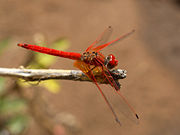
|
|
|
Dragonflies in culture
In Europe, dragonflies have often been seen as sinister. Some English vernacular names, such as " devil's needle" and "ear cutter", link them with evil or injury. A Romanian folk tale says that the dragonfly was once a horse possessed by the devil, and Swedish folklore holds that the devil uses dragonflies to weigh people's souls. Another Swedish legend holds that trolls use the dragonflies as spindles when weaving their clothes (hence the Swedish word for dragonfly trollslända, lit. "troll's spindle") as well as sending them to poke out the eyes of their enemies. The Norwegian name for dragonflies is "Øyenstikker", which literally means Eye Poker. They are often associated with snakes, as in the Welsh name gwas-y-neidr, " adder's servant". The Southern United States term "snake doctor" refers to a folk belief that dragonflies follow snakes around and stitch them back together if they are injured. The Lithuanian word " Laum žirgis" is a composite word meaning "the Lauma's horse", while in Dutch, Aeshna mixta is called " Paardenbijter" or "horse biter". In some South American countries, dragonflies are also called matacaballo (horse killer), or caballito del diablo (devil's horse), since they were perceived as harmful, some species being quite large for an insect.
In East Asia and among Native Americans, dragonflies have a far better reputation, one that can also be said to have positively influenced modern day views about dragonflies in most countries.
For some Native American tribes they represent swiftness and activity, and for the Navajo they symbolize pure water. Dragonflies are a common motif in Zuni pottery; stylized as a double-barred cross, they appear in Hopi rock art and on Pueblo necklaces. It is said in some Native American beliefs that dragonflies are a symbol of renewal after a time of great hardship.
In Japan dragonflies are symbols of courage, strength, and happiness, and they often appear in art and literature, especially haiku. In ancient mythology, Japan was known as Akitsushima, which means "Land of the Dragonflies". The love for dragonflies is reflected by the fact that there are traditional names for almost all of the 200 species of dragonflies found in and around Japan. Japanese children catch large dragonflies as a game, using a hair with a small pebble tied to each end, which they throw into the air. The dragonfly mistakes the pebbles for prey, gets tangled in the hair, and is dragged to the ground by the weight.
They also have traditional uses as medicine in Japan and China. In some parts of the world they are a food source, eaten either as adults or larvae; in Indonesia, for example, they are caught on poles made sticky with birdlime, then fried in oil as a delicacy.
Vietnamese people have a traditional way to forecast rain by seeing dragonflies: "Chuồn chuồn bay thấp thì mưa, bay cao thì nắng, bay vừa thì râm" (Dragonflies fly at low level, it is rainy; dragonflies fly at high level, it is sunny; dragonflies fly at medium level, it is shadowy).
Images of dragonflies were common in Art Nouveau, especially in jewelry designs. They have also been used as a decorative motif on fabrics and home furnishings.
